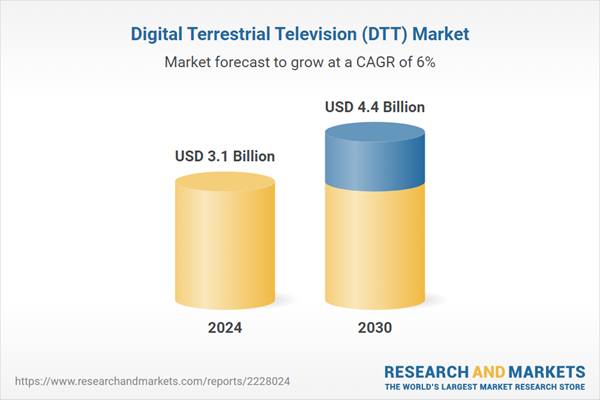Global Digital Terrestrial Television (DTT) Market - Key Trends and Drivers Summarized
Digital Terrestrial Television (DTT) marks a significant evolution in broadcast media, offering a way to transmit television content via airwaves using antennas, which enhances efficiency and accessibility compared to traditional analog systems. This shift allows for high-definition content transmission at no extra cost and with improved audio and visual quality. Around the globe, various standards such as ATSC in North America, DVB-T in Europe, ISDB-T in parts of South America and Asia, and DTMB-T/H in China, reflect diverse regional needs and technological adaptabilities. The conversion from analog to digital broadcasting, completed in many developed nations, optimizes the use of the radio spectrum, which benefits other vital services like emergency communications, and expands consumer access to multiple channels without the need for expensive subscription services.However, transitioning to digital platforms poses challenges, especially in less developed regions or among populations with limited internet connectivity and technical skills. The digital divide remains pronounced, with affordability and accessibility issues hindering the full adoption of new technologies. In rural and remote areas, where implementing cable and satellite services can be economically challenging, DTT proves crucial as it doesn't require extensive infrastructure to reach a wider audience. This ensures that high-quality broadcasting remains available to those previously underserved by traditional media, thereby democratizing access to information and entertainment.
Several growth drivers are propelling the adoption of DTT. Regulatory support and mandates by governments worldwide to switch from analog to digital broadcasting encourage this transition, often accompanied by subsidies to assist consumers with purchasing necessary equipment. DTT's cost-effectiveness attracts consumers seeking free-to-air services without recurring fees, while its capability for multiplexing allows broadcasters to offer a diverse range of programming, including niche channels. Enhanced broadcast quality in audio and video, coupled with interactivity and convergence with internet-based services, meets rising consumer expectations for high-definition content and interactive experiences. Moreover, with the growing demand for mobile access to media, DTT systems have adapted to provide services to portable devices, catering to the modern consumer's need for flexibility and mobility in media consumption. Collectively, these factors drive the continual growth and expansion of digital terrestrial television, aligning with consumer preferences and the technological advancements in broadcasting.
Report Scope
The report analyzes the Digital Terrestrial Television (DTT) market, presented in terms of market value. The analysis covers the key segments and geographic regions outlined below.- Segments: Segment (Digital Terrestrial Television (DTT)).
- Geographic Regions/Countries: World; United States; Canada; Japan; China; Europe (France; Germany; Italy; United Kingdom; Spain; Russia; and Rest of Europe); Asia-Pacific (Australia; India; South Korea; and Rest of Asia-Pacific); Latin America (Argentina; Brazil; Mexico; and Rest of Latin America); Middle East (Iran; Israel; Saudi Arabia; United Arab Emirates; and Rest of Middle East); and Africa.
Regional Analysis
Gain insights into the U.S. market, valued at $807.3 Million in 2024, and China, forecasted to grow at an impressive 8.9% CAGR to reach $997.2 Million by 2030. Discover growth trends in other key regions, including Japan, Canada, Germany, and the Asia-Pacific.Why You Should Buy This Report:
- Detailed Market Analysis: Access a thorough analysis of the Global Digital Terrestrial Television (DTT) Market, covering all major geographic regions and market segments.
- Competitive Insights: Get an overview of the competitive landscape, including the market presence of major players across different geographies.
- Future Trends and Drivers: Understand the key trends and drivers shaping the future of the Global Digital Terrestrial Television (DTT) Market.
- Actionable Insights: Benefit from actionable insights that can help you identify new revenue opportunities and make strategic business decisions.
Key Questions Answered:
- How is the Global Digital Terrestrial Television (DTT) Market expected to evolve by 2030?
- What are the main drivers and restraints affecting the market?
- Which market segments will grow the most over the forecast period?
- How will market shares for different regions and segments change by 2030?
- Who are the leading players in the market, and what are their prospects?
Report Features:
- Comprehensive Market Data: Independent analysis of annual sales and market forecasts in US$ Million from 2024 to 2030.
- In-Depth Regional Analysis: Detailed insights into key markets, including the U.S., China, Japan, Canada, Europe, Asia-Pacific, Latin America, Middle East, and Africa.
- Company Profiles: Coverage of players such as Facebook Inc., Google Inc., LINE Corporation, LinkedIn Corporation, Microsoft Corp. and more.
- Complimentary Updates: Receive free report updates for one year to keep you informed of the latest market developments.
Some of the 57 companies featured in this Digital Terrestrial Television (DTT) market report include:
- Arelis Group
- ARRIS International plc
- GS Group
- Koninklijke Philips N.V.
- Sichuan Changhong Network Technologies Co., Ltd.
- STRONG Ges.m.b.H.
- Technicolor SA
- TechniSat Digital GmbH
- TELE System Digital Srl
- Televes
This edition integrates the latest global trade and economic shifts into comprehensive market analysis. Key updates include:
- Tariff and Trade Impact: Insights into global tariff negotiations across 180+ countries, with analysis of supply chain turbulence, sourcing disruptions, and geographic realignment. Special focus on 2025 as a pivotal year for trade tensions, including updated perspectives on the Trump-era tariffs.
- Adjusted Forecasts and Analytics: Revised global and regional market forecasts through 2030, incorporating tariff effects, economic uncertainty, and structural changes in globalization. Includes historical analysis from 2015 to 2023.
- Strategic Market Dynamics: Evaluation of revised market prospects, regional outlooks, and key economic indicators such as population and urbanization trends.
- Innovation & Technology Trends: Latest developments in product and process innovation, emerging technologies, and key industry drivers shaping the competitive landscape.
- Competitive Intelligence: Updated global market share estimates for 2025, competitive positioning of major players (Strong/Active/Niche/Trivial), and refined focus on leading global brands and core players.
- Expert Insight & Commentary: Strategic analysis from economists, trade experts, and domain specialists to contextualize market shifts and identify emerging opportunities.
Table of Contents
Companies Mentioned (Partial List)
A selection of companies mentioned in this report includes, but is not limited to:
- Arelis Group
- ARRIS International plc
- GS Group
- Koninklijke Philips N.V.
- Sichuan Changhong Network Technologies Co., Ltd.
- STRONG Ges.m.b.H.
- Technicolor SA
- TechniSat Digital GmbH
- TELE System Digital Srl
- Televes
Table Information
| Report Attribute | Details |
|---|---|
| No. of Pages | 203 |
| Published | December 2025 |
| Forecast Period | 2024 - 2030 |
| Estimated Market Value ( USD | $ 3.1 Billion |
| Forecasted Market Value ( USD | $ 4.4 Billion |
| Compound Annual Growth Rate | 6.0% |
| Regions Covered | Global |









